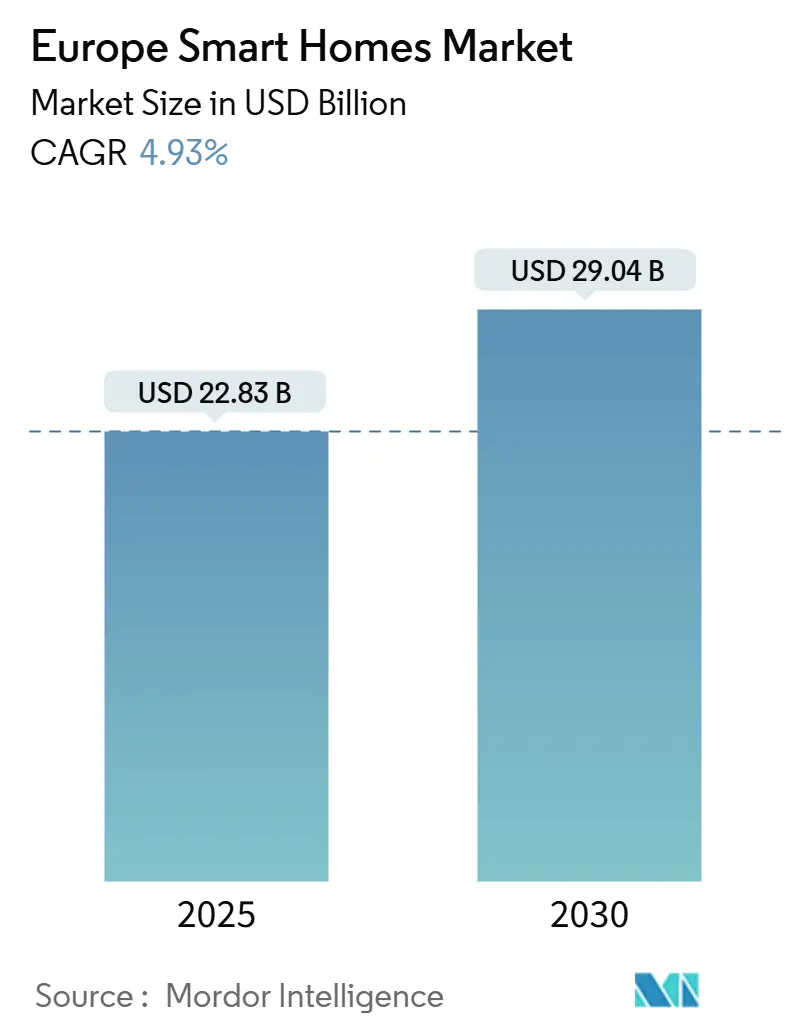
| Study Period | 2019 - 2030 |
| Base Year For Estimation | 2024 |
| Forecast Data Period | 2025 - 2030 |
| Market Size (2025) | USD 22.83 Billion |
| Market Size (2030) | USD 29.04 Billion |
| CAGR (2025 - 2030) | 4.93 % |
| Market Concentration | Low |
Major Players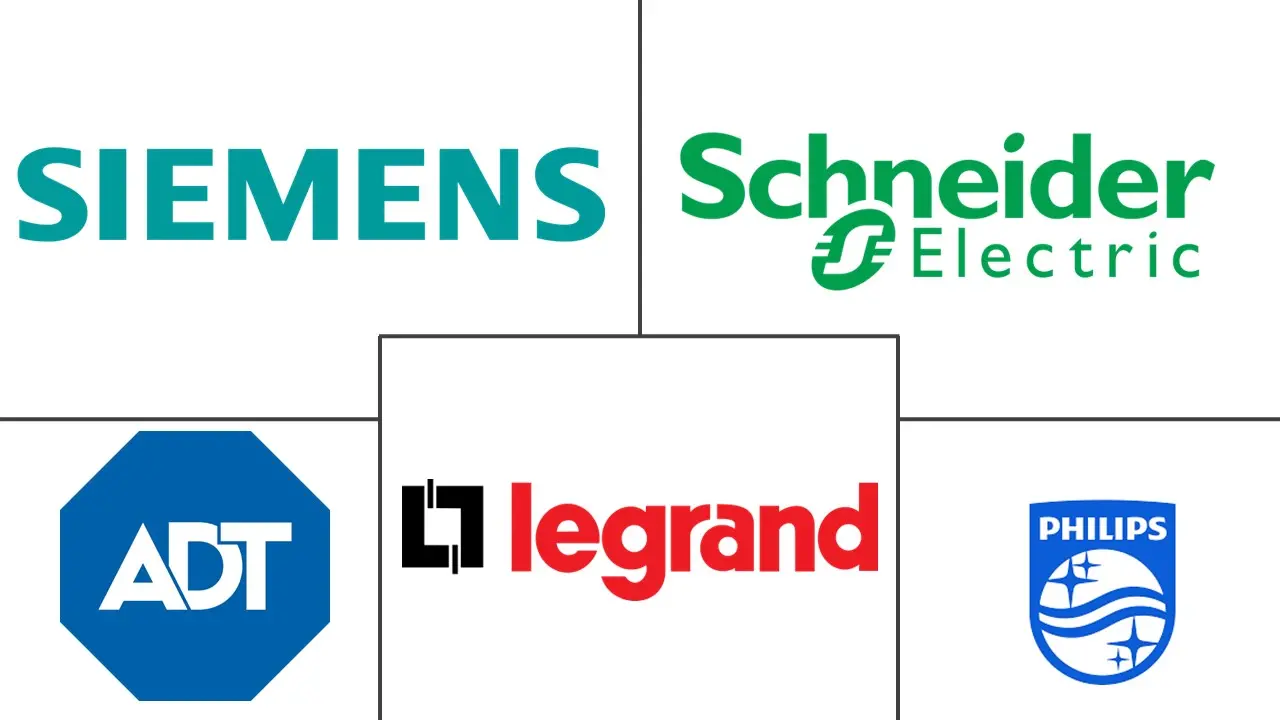
*Disclaimer: Major Players sorted in no particular order |
Europe Smart Homes Market Analysis
The Europe Smart Homes Market size is estimated at USD 22.83 billion in 2025, and is expected to reach USD 29.04 billion by 2030, at a CAGR of 4.93% during the forecast period (2025-2030).
- The demand for remote home monitoring has increased as internet usage has spread across more nations. This offers premium home and property security, boosting the market throughout the projection period.
- Smart urban technologies has made a significant contribution to the sustainable development of European cities. According to European Comission, 75 percent of the EU population lives in urban areas, a proportion that is continuously rising as the urbanisation trend continues, both in Europe. With this, the growing investment towards making creating smart cities has also surged. This is because a smart city is an entity that utilizes ICT effectively for integrating all the needs of its urban community, in terms of energy and other utilities, environmental protection, mobility and transport, services for citizens and with proper regard for security, both of individuals and their personal data, and using it as a driver for economic and social improvements.
- This is expected to increase the deployment of smat homes technologies in rural communities, thus creating conditions for making smart communities attractive to the population. One of the present instances of smart home deployments engaged in promoting smart city advantages is the integration of smart thermostats into utility demand management programs.
- The new generation of smart home devices, like connected light bulbs, smart locks, and smart speakers, are driving this increase. Due to the emergence of numerous startups in the field of smart homes and IoT devices during the past few years, the market has rapidly fragmented. As a result of this scenario, the cost of smart home technology significantly dropped, encouraging its uptake in the area.
- The rapid adoption of contemporary technologies, including artificial intelligence (AI), blockchain, the internet of things (IoT), smart voice recognition, and others, have significantly impacted the market expansion. The technology enables users' voices to be recognized by smart home items so they can respond to them individually.
- The popularity of digital assistants like Alexa, Google Assistant, Siri, and Bixby has made it possible to operate smart devices using voice commands. The new features of these digital assistants, such as control Bluetooth speakers and hands-free channel surfing, drive the demand for smart home products in the market.
- Home automation is becoming increasingly accessible, allowing for remote control of lighting, heating, air conditioning, and online communication. However, if the technology is challenging to use, older people and people with physical limitations might only sometimes be able to take advantage of it. To spur market growth in the upcoming years, the European Union (EU) has invested in some of the most significant smart home initiatives for senior citizens.
- Moreover, the security and access control segment is anticipated to dominate the market. By utilizing live feed playback, personalized PINs, fingerprint scanners, and other features, smart locks and security cameras assist in monitoring and authorizing access only to authorized personnel. For instance, in September 2022, Amazon.com launched the 2nd Gen Ring Alarm Panic Button, Ring Spotlight Cam Pro, and Ring Spotlight Cam Plus for security and access management using capabilities including 3D motion detection and radar.
- Due to the extremely high cost of the systems, ROI has shown to be difficult since it often takes at least four years to recoup the cost of an EMS installation, particularly for an EMS. These systems have a high degree of complexity, and multiple firms' strategies are frequently combined. Installation can only be completely done with difficulty, and installation expenses are likewise significant. In addition to this, brands don't support conversation regarding the incompatibility which is one of the biggest problem with smart home technology. For instance, installing multiple devices and platforms may result into the unfortunate realization that gadgets won't communicate with each other.
- Moreover, humankind has changed their home design taste from the COVID-19 pandemic, which is expected to have a signficant impact on the market studied. The consumer's propensity of adopting security solutions is rising owing to the pandemic scenario and the uncertainty of returning to everyday life. A 'smart home' looks more practical in the 'new normal' post-COVID-19.
Europe Smart Homes Market Trends
Energy Management Systems to Witness Significant Growth
- An energy management system (EMS) is a computer-assisted tool used by electric utility grid managers to track and improve the performance of the generation and transmission system. Energy efficiency is increasingly taking center stage in the region for private businesses and governmental organizations. The expanding economic activity must result in high energy consumption rates, exceeding the capacity of the region's electricity infrastructures.
- However, the current European legislative approach needs to go further to encourage smart buildings, with the Energy Performance of Buildings Directive (EPBD) and the Energy Efficiency Directive (EED) merely encouraging the installation of smart meters and intelligent metering systems.
- Products like smart meters, smart plugs, and smart thermostats are becoming more popular among end users in the region in the IoT era since they are a component of the smart home ecosystem with energy monitoring solutions. In recent years, smart energy meters have gained much popularity. Smart houses are beginning to appreciate the advantages of smart meters and anticipate that they will improve the effectiveness and precision of utility management.
- Also, due to the Russia-Ukraine war, energy and gas prices have increased. For instance, as per the department for business, energy, and Industrial Strategy, domestic electricity prices increased by 45 percent, and domestic gas prices increased by 84 percent. Most of this increase occurred in the second quarter of 2022, reflecting the increase in the default price cap from 1st April 2022. Such an increase in energy pricing further creates the potential for adopting EMS across many homes.
- Further, Energy management solutions are being used by homes more frequently as a result of government mandates, cost reductions, and energy efficiency improvements. Costs are decreased by the primary EMS measurement, communication, and software application components. According to an MIT study, buildings lose at least 30 percent of their energy, and EMS can help reduce this.
- For instance, through Innovate UK, an innovation agency, the UK government has implemented a series of programs that provide direct funding to cities for investing in smart initiatives. As per a report by the European Parliament, the United Kingdom is one of only three European countries with more than 31 cities with at least one smart initiative. Such developments are expected to drive opportunities for the market studied.
- Furthermore, the UK government mandates that energy suppliers install smart meters in 26 million homes. The accelerating smart meter rollout and growing awareness of the energy crisis, coupled with the European directive to reduce 80 percent of carbon emissions by 2050, have been identified as the major factors influencing the country's home energy management system's growth.
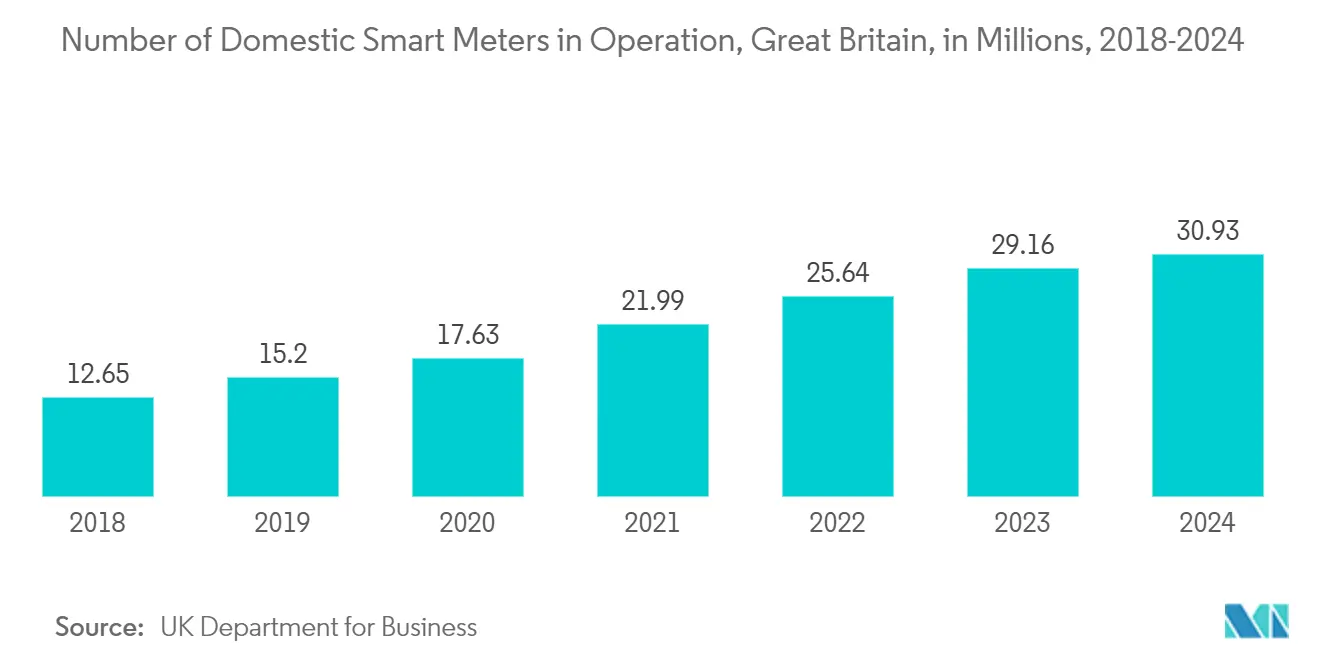
Germany is Expected to Hold Significant Market Share
- Germany has been focusing on long-term sustainable energy since 2010. The country approved the Energy Concept, a strategic blueprint for implementing renewable energy. This plan creates a pathway with renewable energy as its cornerstone toward the year 2050.
- Moreover, by addressing funding schemes for energy efficiency measures and audits in the National Action Plan Energy Efficiency plan, the German government is on track to rank among the world's most energy- and environmentally-friendly nations. According to the Ministry for Economic Affairs, the country intends to lower its primary energy usage by 30 percent by 2030 compared to 2008.
- Additionally, the government and businesses have launched several energy-saving projects to promote the use of smart home goods and services. For instance, the "Smart Energy Showcases - Digital Agenda for the Energy Transition" award project was established by the German Federal Ministry of Economic Affairs and Energy in February 2022. This effort aims to install and test cutting-edge energy solutions while involving market actors from all points along the value chain.
- The main governing body for the nation's energy policies continues to be the "Energiewende," generally known as Germany's energy transformation effort. The Energiewende is a realistic plan for improving the efficiency and proportion of renewable sources in the nation's energy system, seen in electricity generation. In brand-new or completely refurbished smart houses, the Energiewende mandates the installation of smart meters. It promotes the construction of efficient ventilation, heating, and insulation systems.
- German consumers are utilizing smart home solutions at an increasing rate, and one of the primary motivators is the desire for greater security. The German smart home market is driven by providers always working on creating security solutions. Moreover, Because of the rise in home automation and the need to increase energy efficiency, smart lighting solutions are also anticipated to continue to dominate the market. Due to the rising demand for wireless technologies in smart homes, the need for smart bulbs in the area is expected to rise at the fastest rate over the projected period.
- Additionally, the area is improving its energy management system through the reimbursement of the EEG tax by the German Renewable Energy Act and with the certification of the ISO 50001, a framework for the supply, application, and consumption of energy in buildings. As a result, the area market is anticipated to grow significantly due to government programs and increased vendor investment in green homes. For instance, Denmark and Germany agree to a landmark energy project that can supply about 4.5 million European homes with green electricity.
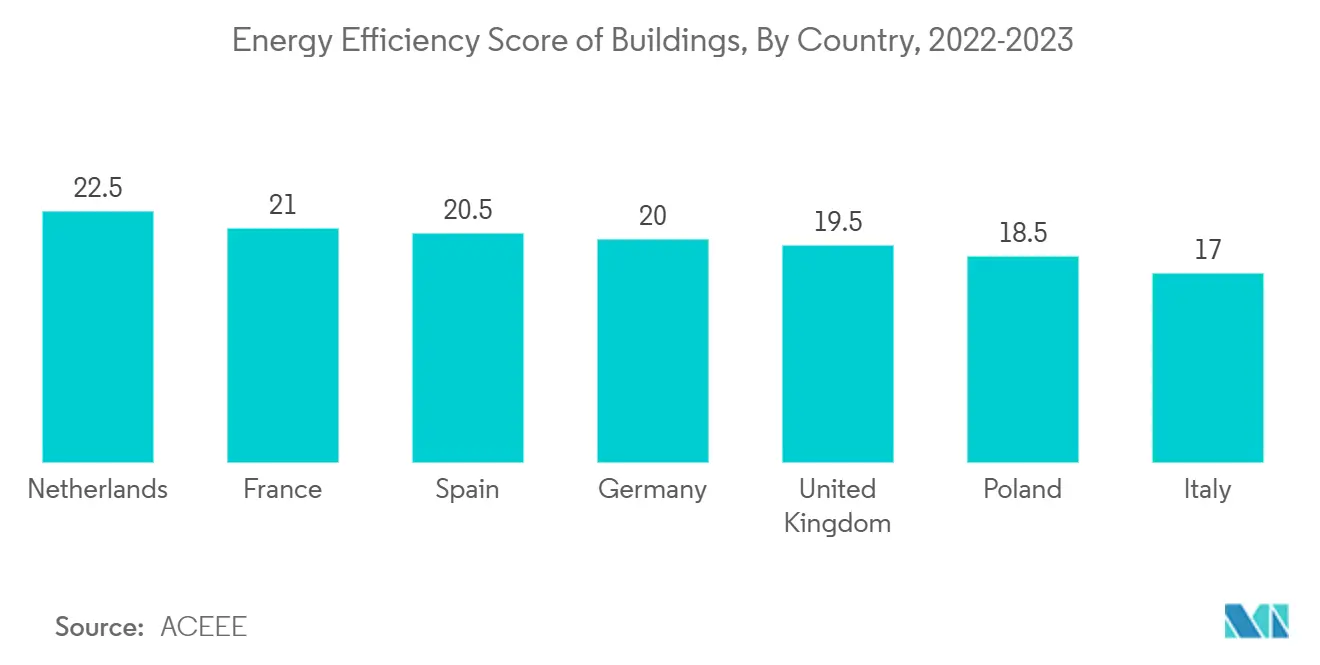
Europe Smart Homes Industry Overview
The European Smart Homes market is fragmented with key players in the industry such as Siemens AG, Legrand SA, Schneider Electric, Philips Lighting, ADT, and more. These companies are contributing to the market by investing in new product innovations with lower costs and more energy-efficient products.
The European smart home market is poised for significant growth driven by energy efficiency initiatives, heightened security demands, and technological advancements. As consumers increasingly adopt smart technologies for convenience and safety, stakeholders must navigate challenges related to costs and privacy to fully capitalize on emerging opportunities.
- August 2023 - Vodafone has signed a service agreement with Data Communications Company (DCC) to provide a 4G connectivity upgrade for Britain’s smart meter network. t will run for up to 15 years to build and operate 4G managed internet of things (IoT) connectivity for Britain’s smart meter network, which already securely connects more than half of homes to energy suppliers and operators.
- January 2023 - Apple Inc has been working towards developing new smart home products in an effort to grow its footprint in the smart home market. The new products will range from a speedier Apple TV set top box to a smart display tablet that can control thermostats and lights, show video and handle FaceTime chats, and can be mounted on the wall. The expansion of Apple's home lineup is expected to aid it compete in the smart home market currently dominated by Amazon and Google .
Europe Smart Homes Market Leaders
-
Siemens AG
-
Legrand SA
-
ADT Security Services
-
Philips
-
Schneider Electric
- *Disclaimer: Major Players sorted in no particular order
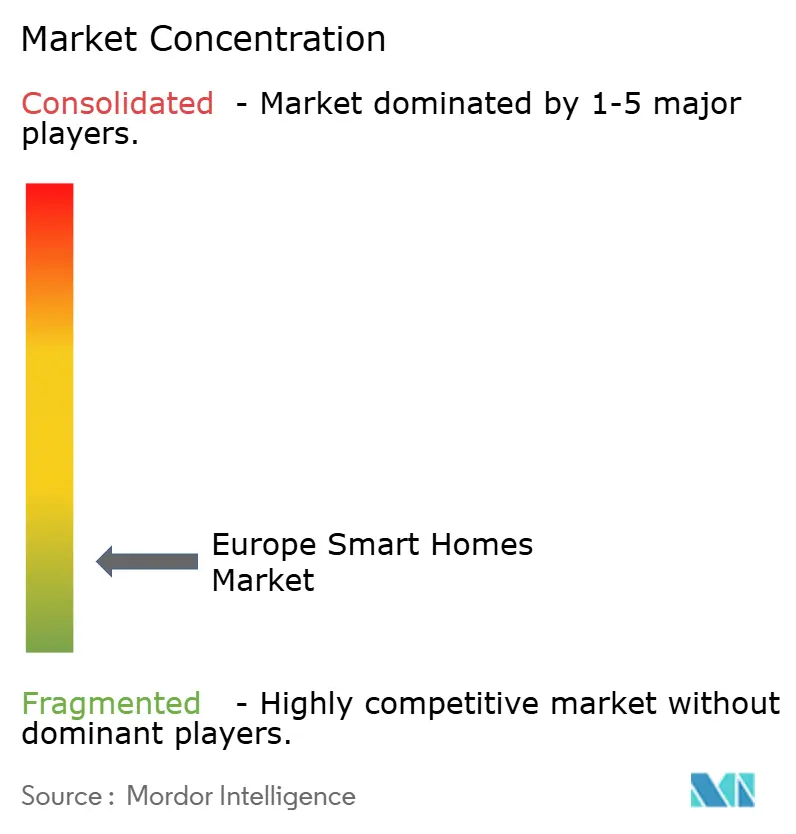
Europe Smart Homes Market News
- October 2024: Fibocom launched a new series of LTE Cat 1bis modules LE270-CN/LE270-EU/LE270-LA featuring ultra-compact size and ultra-low power consumption for the utility industries, empowering smart electricity meters, water meters, and gas meters with uncompromised performance and reliable 4G connectivity.
- January 2024: Quectel Wireless Solutions, a global IoT solutions provider, and Morse Micro, the leading Wi-Fi HaLow silicon vendor, announced that the Quectel FGH100M Wi-Fi HaLow module has received CE certification for Europe and Federal Communications Commission (FCC) certification for the US. The CE and FCC certification of the module, powered by Morse Micro’s MM6108 SoC, underscores the rigorous testing and compliance with the highest standards of safety, health, and environmental protection required in the European Area.
Europe Smart Homes Industry Segmentation
A smart home is a practical home design where electronics and appliances may be remotely controlled through the internet from any location using a smartphone or other networked device. The internet connects the devices in a smart home, enabling users to remotely control features like temperature, lighting, security access, and home entertainment systems.
Europe Smart Home Market is segmented by product type (lighting products, energy management, security, connectivity, energy management systems, home entertainment, and smart appliances) and country (United Kingdom, Germany, France, Italy, Netherlands, Rest of Europe). The market sizes and forecasts are provided in terms of value (USD) for all the above segments.
| By Product Type | Lighting Products |
| Energy Management | |
| Security | |
| Connectivity | |
| Energy Management systems | |
| Home Entertainment & Smart Appliances | |
| By Country | United Kingdom |
| Germany | |
| France | |
| Italy | |
| Netherlands | |
| Rest of Europe |
Europe Smart Homes Market Research FAQs
How big is the Europe Smart Homes Market?
The Europe Smart Homes Market size is expected to reach USD 22.83 billion in 2025 and grow at a CAGR of 4.93% to reach USD 29.04 billion by 2030.
What is the current Europe Smart Homes Market size?
In 2025, the Europe Smart Homes Market size is expected to reach USD 22.83 billion.
Who are the key players in Europe Smart Homes Market?
Siemens AG, Legrand SA, ADT Security Services, Philips and Schneider Electric are the major companies operating in the Europe Smart Homes Market.
What years does this Europe Smart Homes Market cover, and what was the market size in 2024?
In 2024, the Europe Smart Homes Market size was estimated at USD 21.70 billion. The report covers the Europe Smart Homes Market historical market size for years: 2019, 2020, 2021, 2022, 2023 and 2024. The report also forecasts the Europe Smart Homes Market size for years: 2025, 2026, 2027, 2028, 2029 and 2030.
Our Best Selling Reports
Europe Smart Homes Industry Report
Statistics for the 2025 Europe Smart Homes market share, size and revenue growth rate, created by Mordor Intelligence™ Industry Reports. Europe Smart Homes analysis includes a market forecast outlook for 2025 to 2030 and historical overview. Get a sample of this industry analysis as a free report PDF download.




